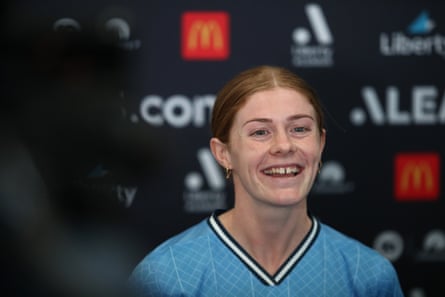
The Matildas effect. This sentence can be used to describe the paradigm-changing impact of Tony Gustavsson’s team at the Women’s World Cup. In a remarkable month, ratings records fell, viewership boards shattered and the public rejoiced. In the end, there was a feeling that Australia was forced to recalculate not only what was possible for women’s football or women’s sport or football or sport, but also its cultural points of contact.
Now, two months later, Australia’s home league, the A-League Women (ALW), is returning. It continues against the backdrop of expectations and desires. An overwhelmingly successful home World Cup creates fertile ground to raise the league’s profile, encourage further investment and bring greater attention to the players, teams, stories and football that populate it.
Every member of the Matildas team the country fell in love with in July and August was in the league at some point. A handful remained in Australia to play in the coming season. This is the league where the next generation develops right in front of the fans. That should mean something, right?
Capitalizing on the momentum of the World Cup represents the greatest opportunity the league will ever have to grow its fortunes and reach a newly engaged audience. At least 4.9 million people were glued to their screens as Cortnee Vine side-footed a penalty past Solène Durand to send the Matildas into the semi-finals of their home tournament. A staggering 11.15 million viewers tuned in days later as Australia lost 3-1 to England, the highest TV figure since records began in 2001. It wouldn’t take a large proportion of viewers to make a tangible difference in fortunes the league – this was proven by the record pre-season sales of half of the league’s clubs and sold-out opening round games.
Vine, a key figure for defending champions Sydney, has been re-signed as a star and has become the face of the league’s marketing efforts. There had been speculation that she would travel abroad, so her return is a key part of the league’s efforts to appeal to World Cup audiences (and a handy boost to the Harborsiders’ title defense). Vine will be joined by national teammates Kyah Simon at Central Coast, Tameka Yallop at Brisbane and Lydia Williams at Melbourne Victory as part of a strategic league push. Elsewhere this season will also feature notable international and World Cup personalities such as Emily Gielnik, Elise Kellond-Knight, Chloe Logarzo, Sarina Bolden, Hannah Wilkinson and Rebekah Stott.
after newsletter advertising
The addition of the Mariners as an expansion team will take the league to 12 teams in the 2023/24 season and allow it to run a full home and away season – the first Australian women’s football regime to do so. The cathartic joy that the league had finally reached this point was clear on Logarzo’s face at Tuesday’s season-opening event. The long-advocated move represented a decisive step towards full professionalism and year-round employment for Australian players: “We’ve been waiting for this for 16 years.”
Importantly, a proper season gives fans old and new more scope to engage and socialize with the league and its supporters over a longer period of time. It often feels like women’s leagues disappeared as soon as they were introduced; Minor injuries lead to the end of the season, poor form sees you eliminated from the competition early and storylines end before they begin. But in the ALW there is now a chance for more.
And yet this is Australian football. The history of this fatalistic game is littered with missed opportunities.

A once-in-a-lifetime home World Cup is just that: once in a lifetime. The tournament has tilled the ground but also represents a Rubicon moment. There will never be a better time than now. A-Leagues commissioner Nick Garcia said the aim was to make the league a destination for players around the world. But goals like this require long-term, sustainable investment and planning. During the World Cup, Kellond-Knight clearly noted that the stadium captured the imagination not only because of the world-class football, but also because of the high quality of the stadiums, coverage, facilities and more. This is the end point. Players need to be empowered to succeed and a substandard product on or off the field will not generate sustained engagement.
While it is easy to say that something has changed in Australia, it is difficult to determine what that was and whether the impact will herald a new era for the ALW, as opposed to a short-term sugar decline. The Matildas Effect may still be without definition: its greatest beneficiary is the one who can mobilize and define it for their own ends and means.
It will take years to know whether the ALW can do this. The goal is not just to set records in the first round of the 2023-24 season, but to set them again next week, next month and next season. That journey begins this week.
